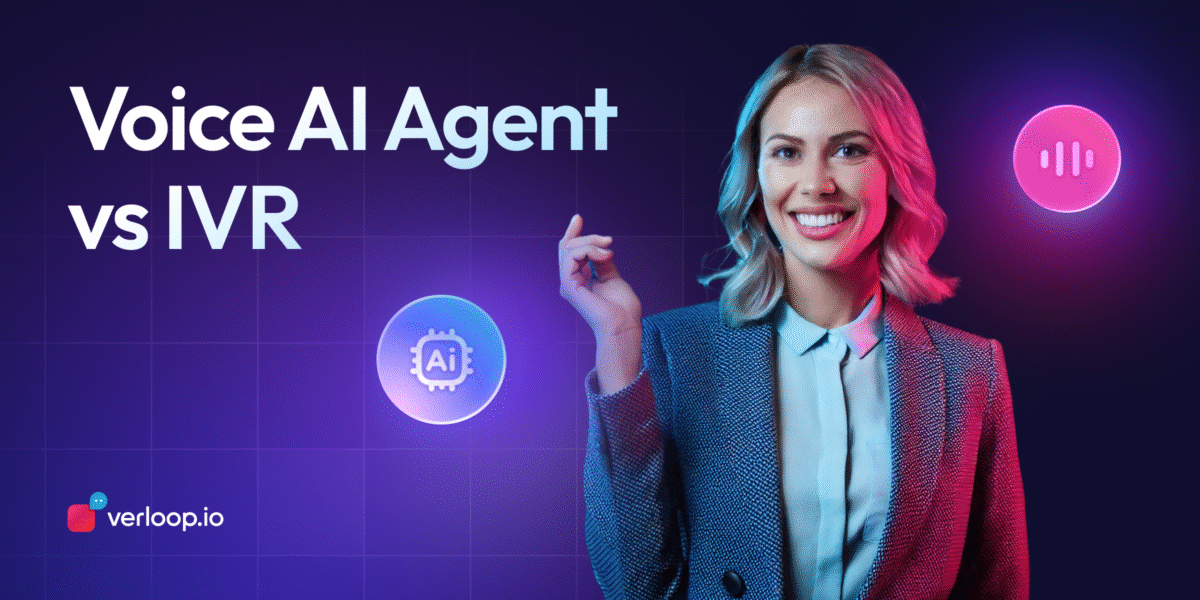Beyond Button-Mashing: IVR vs Voice AI Agent in Customer Support
- May 8th, 2025 / 8 Mins read
-
Aarti Nair

Beyond Button-Mashing: IVR vs Voice AI Agent in Customer Support
- May 8th, 2025 / 8 Mins read
-
Aarti Nair
Today, providing excellent customer support is essential for any business to thrive. However, addressing each customer individually is impractical, especially for common or repetitive questions.
This is where IVR and Conversational AI come in. Both effectively handle straightforward customer inquiries and efficiently connect them with the right agents when needed. Hence, freeing up agents for more complex issues.
IVR, or Interactive Voice Response, utilises keypads or voice commands to guide customers navigate through pre-recorded messages and prompts. It helps customers with basic questions or connect them with the appropriate agent/department.
Conversational AI, built on Natural Language Processing (NLP), facilitates more natural interactions through chatbots or virtual assistants. It understands and responds to a wider range of customer inquiries.
Conversational AI holds a distinct advantage over IVR systems, particularly in its chat and voice functionalities, thanks to its intelligence. Enterprises increasingly recognize the limitations of non-automated systems and are actively seeking AI-powered support options to address these challenges.
While both technologies enhance customer support, they have distinct features and functionalities. This blog will help you better understand the differences and analyse the future aspects of both systems.
Suggest reading: Transforming Customer Support with Cutting-Edge Voice AI Technology
Comparative analysis of Voice AI Agent and IVR
To understand the difference, let us tell you a story highlighting the difference between Voice AI agents and traditional IVR systems.
A few months ago, Priya dialled her internet provider’s helpline hoping to resolve a billing issue quickly. Instead, she found herself trapped in an endless maze of “Press 1 for this, Press 2 for that,” with no human in sight—or sound. Frustrated, she hung up. The next day, she tried calling another service that used a Voice AI Agent. Within seconds, a conversational voice greeted her, understood her issue, and routed her to the right solution—no button-mashing required. This shift in experience isn’t just Priya’s story; it reflects a broader evolution in how businesses are redefining voice support.
| Feature | IVR (Interactive Voice Response) | Voice AI Agent |
|---|---|---|
| Technology Base | Rule-based, menu-driven | AI/ML and NLP-powered |
| User Experience | Static and linear | Dynamic, conversational |
| Response Flexibility | Limited to predefined options | Can handle open-ended queries |
| Call Containment Rate | Lower | Higher |
| Personalisation | Generic, one-size-fits-all | Contextual, user-specific |
| Setup and Maintenance | Manual updates required | Self-learning with continuous improvement |
| Integration Capability | Limited backend integration | Seamless integration with CRMs and APIs |
| Time to Resolution | Often longer | Typically shorter |
| Cost Efficiency | Lower upfront cost, high long-term | Higher upfront, but better ROI over time |
1. Technology
IVR relies on pre-recorded instructions to guide callers to press specific keys on the telephone system. It allows them to access information based on their inquiries or receive assistance from a company representative. However, the predetermined script limits the conversational flow’s ability to adjust to user needs.
Conversational AI call automation solutions, on the other hand, utilises NLP and ML, which enables the tool to train from vast amounts of data. Consequently, the system comprehends and processes human language more effectively. This allows customers to engage in natural conversations and arrive at conclusions more quickly, either through finding a great solution or connecting swiftly with agents.
2. User Interaction
Traditional IVRs are menu-driven, requiring users to press buttons that may not align with their needs. Hence, this leads to frustration as they may need to explore multiple options or repeat the process.
Verloop.io’s conversational AI provides open natural dialogue regardless of word choice. Customers can come straight to the point and explain their problems. The system will then offer a personalised and engaging experience.
3. Capabilities
IVRs excel at directing callers to relevant representatives and offering basic troubleshooting based on predefined solutions. But, open-ended questions can pose a challenge. However, their ability to gather information like names, account numbers, and order details streamlines the process.
Also, IVRs function smoothly even offline, ensuring uninterrupted service regardless of internet connectivity.
Conversational AI call automation can deal with deeper issues as it is capable of understanding complex language and intent. Hence it can ask clarifying questions, and suggest personalised solutions. And create a more engaging and natural dialogue. Moreover, it’s capable of learning and adapting based on user interaction and feedback.
4. Strength
A basic IVR system is cost-effective, while advanced features may increase expenses. It efficiently manages high call volumes during peak times, freeing up agents to address critical queries. Additionally, it can handle multiple calls simultaneously and adapt to fluctuating call volumes. Implementation is straightforward, with vendors providing IVR functionality as a service software, enabling remote operation.
Conversational AI tools like chatbots and voice AI agents enable users to solve problems independently by offering related articles, guides, instructions, and other useful content based on their concerns. Additionally, since AI tools process more data than humans, they can provide more informed solutions. They can also analyse customer behaviour to anticipate future needs, leading to higher customer satisfaction.
5. Weakness
Interactive Voice Response (IVR) systems typically present customers with predetermined options aligned with the organisation’s services rather than addressing the specific reasons for their calls. That often results in negative experiences. At the same time, while menu options may appear comprehensive, they can induce decision fatigue.
Additionally, despite some IVR systems offering voice recognition capabilities, they are not flawless, as varying accents, background noise, and unclear pronunciations can lead to errors.
Developing a high-quality conversational AI system can be expensive due to additional costs associated with data acquisition, annotation, training processes, and ongoing maintenance. Additionally, training the system requires the collection and annotation of large amounts of data, which can be time-consuming and resource-intensive. Despite these efforts, the system may still misinterpret users’ intents at times.
Choosing the right system
Choosing the right customer support system isn’t a one-size-fits-all proposition. Several factors play a crucial role in selecting the best fit for your business.
So let’s look at some of the factors that you should consider.
1. Consider your budget and customer volume
IVR is a budget-friendly option that requires lower development and maintenance costs. So if you have budget constraints, you can go for it. It can efficiently handle large volumes of calls simultaneously. Conversational AI phone call automation solutions on the other hand might be suitable for organisations with more resources.
2. Evaluate the complexity of your customer inquiries
If your business is mostly bombarded with simple queries such as order tracking, return requests, refunds etc, an IVR system with clear menus and prompts can be an efficient solution.
However, in the case of in-depth experience, IVR won’t do the job. Voice AI agents allows an open-ended question and gives thoughtful responses rather than just offering pre-recorded choices.
3. Prioritise customer experience and satisfaction
Analyse and identify what your customers value most while interacting with your customer support. You can compare data between IVR and conversational AI across metrics like satisfaction, efficiency, and error rates.
You can conduct in-depth discussions with customers to understand their preferences and desired interaction experience. You can also identify specific areas where IVR lacks and assess if conversational AI phone call automation solutions could fill the gap effectively.
4. Automation and personalization
For some businesses, building long-term relationships with customers matters the most. Customer loyalty hugely depends on feeling valued and understood. In such a care, personalised support plays a crucial role in fostering deeper connections and encouraging repeat business. Empathy and understanding are paramount.
In such a situations, conversational AI became valuable. Otherwise, your business can do with simple automation and basic troubleshooting but capability to handle large volumes of calls. IVR might be a suitable choice.
Hybrid approach
Weighing the importance of advanced customer support and acknowledging the capabilities of traditional IVR, businesses are turning towards conversational IVR. It is a hybrid system, which is the combination of both IVR and conversational AI.
This integration offers the best of both worlds within a single system, eliminating the shortcomings of traditional IVR where customers had to navigate complex menu options.
It offers a more natural and intuitive interface for customers to interact with the company using voice.
Natural language understanding and machine learning make the system sophisticated and advanced. Hence, the system anticipates customer needs, offers personalised greetings, and customises speaking styles based on the conversation’s context.
The intriguing aspect is that the system becomes smarter with each use.
Case studies
1. Scripbox
Scripbox is a digital wealth management company based in Bangalore.
Problem:
They were facing significant challenges in managing the increasing volume of customer queries, especially those related to investments and withdrawals.
The challenge was to respond immediately with high accuracy and no wait time, putting pressure on support agents and hampering customer support.
Solution:
Verloop’s conversational AI platform helped Scripbox automate responses for frequently asked questions.
It allowed them to add responses to standard queries and keywords, enabling the chatbot to understand various intents and provide relevant information to users quickly and accurately.
Positive Impact:
- Scripbox achieved an average First Response Time (FRT) of less than 10 seconds, which is exponentially fast compared to industry standards.
- Audit checks on customer queries achieved a quality score of more than 98%.
- The company experienced a Net Promoter Score (NPS) of 60 after implementing Verloop.io, indicating that customers are not just happy but also likely to recommend Scripbox to others.
2. University of Ottawa Heart Institute
The university conducted a program to investigate the use of IVR to monitor heart failure (HF) patients after discharge from the hospital. Here are the key takeaways:
Problem:
Hospital readmissions for HF are expensive and a major healthcare challenge.
Solution:
This study explored the use of an IVR system to remotely monitor patients at home and identify early signs of worsening symptoms.
Method: 902 HF patients participated in the program for 12 weeks, answering automated phone calls about their symptoms, medication adherence, and lifestyle habits.
Positive impact:
- Overall decrease in hospital readmissions, symptom occurrence, weight gain
- Increase in medication adherence
- Highest compliance with medication adherence.
- Older, female patients from rural areas were more likely to participate and show positive outcomes.
However, the impact would have been much greater if the university had chosen the combination of conversational AI solution in addition to an IVR system.
The future of customer support
The future of customer support will be significantly shaped by advanced artificial intelligence (AI) and its integration with various channels, including augmented reality (AR). This trend has the potential to revolutionise how businesses assist their customers, particularly those facing complex technical issues.
AR integration can allow customer support representatives to easily visualise solutions and guide customers through troubleshooting steps in real time using smartphones, tablets, or even AR glasses.
Additionally, generative AI can empower agents to effectively handle a wider range of customer demographics, cultures, and communication styles by preparing them for diverse needs and providing real-time information accessible during any customer interaction.
By embracing these innovative technologies, businesses can expect to enhance customer satisfaction, reduce resolution times, and improve overall operational efficiency in their support efforts.
Verloop.io delivers a cutting-edge conversational AI solution powered by Generative AI. It understands your customers’ intent and ensures round-the-clock assistance with tailored responses and fast problem resolution. Experience the difference for yourself! Book your demo today and discover how Verloop.io can transform your customer support.

FAQs
1. What is the difference between Voice AI and IVR?
IVR (Interactive Voice Response) is a rule-based system that uses pre-recorded menus and keypad inputs to route calls. Voice AI, on the other hand, uses artificial intelligence, natural language processing (NLP), and machine learning to understand and respond to human speech in real-time. Voice AI offers a more conversational, dynamic experience, while IVR is linear and menu-driven.
2. What is IVR in customer service?
IVR in customer service refers to an automated phone system that interacts with callers, gathers information, and routes them to the appropriate agent or department based on keypad inputs. It’s commonly used to reduce agent workload and manage call volumes.
3. What is the difference between conversational AI and IVR?
Conversational AI, which powers Voice AI agents, enables natural, two-way conversations by understanding context and intent. IVR, however, relies on rigid decision trees and lacks the flexibility to interpret varied speech or follow-ups. Simply put, conversational AI listens to you; IVR waits for you to press a button.
4. What is best suited for my business, IVR or a Voice AI solution?
It depends on your business needs and customer expectations. If you handle high call volumes and want to deliver fast, personalised support at scale, a Voice AI solution is better suited. If you’re on a tight budget and need basic call routing, IVR may suffice—but it lacks the long-term agility and customer experience benefits of Voice AI.
5. Can you integrate a Voice AI solution with other customer support tools like CRM?
Yes. Most Voice AI solutions can integrate seamlessly with CRMs, ticketing systems, knowledge bases, and other customer support platforms. This allows the AI to pull relevant data, personalise interactions, and even update customer records in real time.
6. What is the difference between IVR and a voicebot?
A voicebot is powered by conversational AI and can carry out intelligent, two-way interactions using speech. It understands natural language, context, and user intent. IVR, in contrast, is limited to scripted flows and numeric input, offering little flexibility or personalisation.
7. Why do companies use IVR?
Companies use IVR to manage large call volumes, reduce operational costs, and streamline call routing. It provides basic automation for common queries and helps free up human agents for more complex tasks.
8. What are the disadvantages of IVR?
IVR systems can frustrate users due to their rigid structure, long wait times, and inability to understand natural language. They often lead to poor customer experiences, increased call drop-offs, and a lack of personalisation—issues that Voice AI is specifically designed to address.







